Round The World and other travels
A frequent flyer's collection of trip diaries
This is: Roaming the Rust Belt (2017)
Taste of reality, and a pilgrimage begins
 Once again, Bruce and I were both awake by
0530, our bodies not yet properly adjusted to Eastern Standard Time.
We began the day by enjoying an à la carte hotel breakfast:
I had classic Eggs Benedict, while Bruce enjoyed that other American
favourite, a stack of pancakes with New York maple syrup. Conditions outside were exactly as forecast,
but could scarcely have been more different from the previous day. A
thick blanket of leaden, rain-bearing clouds had moved in overnight,
and the temperature was set to fall further as the day progressed.
By 8 o'clock in the morning, we had already experienced the daytime
high!
Once again, Bruce and I were both awake by
0530, our bodies not yet properly adjusted to Eastern Standard Time.
We began the day by enjoying an à la carte hotel breakfast:
I had classic Eggs Benedict, while Bruce enjoyed that other American
favourite, a stack of pancakes with New York maple syrup. Conditions outside were exactly as forecast,
but could scarcely have been more different from the previous day. A
thick blanket of leaden, rain-bearing clouds had moved in overnight,
and the temperature was set to fall further as the day progressed.
By 8 o'clock in the morning, we had already experienced the daytime
high!
With Bruce at the wheel, we returned to Rochester and this time headed for the downtown area. On arrival, it was instantly clear that it wasn't just the weather that was different: the astonishingly quiet city centre, in stark contrast to the fabulous Neighborhood of the Arts, was thoroughly run down and skanky-looking. Rochester really was part of the Rust Belt, after all! Having said that, our first (and as it turned out, only) stop was genuinely interesting. We parked in the High Falls district, walked out onto the pedestrian-only Pont de Rennes (named after Rochester's twin town), and enjoyed the dramatic views of the waterfall that gave this district its name, and those of the gorge cut by the Genesee River immediately below the falls.
 |
 |
 |
 |
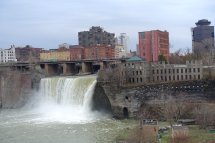 |
 |
 |
 |
 |
That initial stop completed, a short drive in the city's central core revealed an area of unreconstructed squalour. There was simply no point in making a further stop here as there was nothing to see or do. The contrast with the previous day was absolute and really quite shocking. As I became progressively less interested in holding my camera at the ready in the front passenger seat, I could scarcely believe that I had taken all those photos in the same city less than 24 hours ago. Rather than attempt to flog a dead horse, we set course for Rochester Public Market and enjoyed looking around there. After what we had just observed in the downtown area, it was heartening to see people out and about on a Saturday morning, busy replenishing their household stocks of fresh, healthy produce.
 |
 |
 |
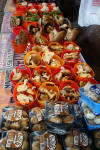 |
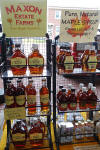 |
 |
 |
 |
 |
Next, we drove approximately 95 miles westwards to Buffalo, at the eastern extremity of Lake Erie. Buffalo is New York's second most populous city, but being home to 260,000 people, it comes a long way indeed behind New York City. Buffalo is at one end of the Canadian border crossing known as the Peace Bridge, which spans the Niagara River. It is 24 miles from the Niagara Falls and around 100 miles from Toronto.
Buffalo was also the place where we intended to begin a significant sub-theme of the trip: a kind of mini-pilgrimage to view the work of the celebrated American architect Frank Lloyd Wright (1867-1959), taking in a total of four sites. On arrival in Buffalo, we made our way directly to the first of these, the Martin House Complex located in the city's Parkside district. We booked onto the 2:30pm tour, and the assistant recommended local restaurant Parkside Meadow a few streets away, opposite Buffalo Zoo. Walking round to our newly identified lunch stop, we realised that our first taste of this new city was again to be in a fabulous neighbourhood featuring beautiful, wood-built houses that could not have been anywhere other than the USA.
 |
 |
| Time for lunch! | |
We had a good (if rather heavy) lunch of toasted sandwich and fries accompanied by a Bloody Caesar, Canada's clam broth-enhanced version of a Bloody Mary. It seemed appropriate, given our current location, and in any case, it always makes for an interesting variation on a favourite cocktail. As we returned to the Martin House Complex, the weather had improved sufficiently to allow a few photographs of the Parkside district, without getting either self or camera completely soaked.
 |
 |
 |
 |
 |
 |
 |
 |
 |
 |
 |
 |
 |
 |
| Seemed like as good a time as any to get a couple of photos of our Volkswagen Jetta | |
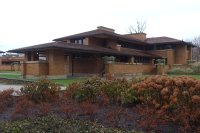 |
| Initial view of the Martin House |
We joined our tour, led by guide Kathy, and learned right away that photography was permitted everywhere except in the main house, onetime family home of client Darwin D Martin, a successful businessman. The complex is now a US National Historical Landmark. The buildings were constructed between 1903 and 1905, and the result is considered to be the most important work from the first half of the architect's career. (The complex also contains the Barton House where Mr Martin's sister lived with her husband, the Carriage House, The Gardener's Cottage, The Conservatory and The Pergola. The latter was demolished in 1962 and rebuilt in the 'noughties'.) We learned some of the signature features of the buildings, such as striving to break down boundaries between outdoors and indoors (perhaps best illustrated by a view straight through the house and out the other side), open-plan layouts, the concept of 'horizontality' (use of long, slim bricks) and the featuring of geometric shapes.
 |
 |
 |
Kathy was able to bring what we were seeing to life, and this proved to be a most enjoyable tour of the property, and a fascinating introduction to the work of one of America's most celebrated architects. (And as far as the current trip was concerned, it was a case of one down, three to go!)
 |
 |
 |
 |
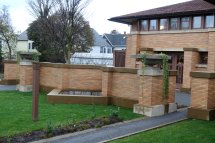 |
|
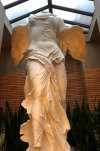 |
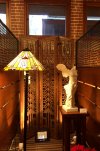 |
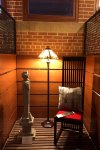 |
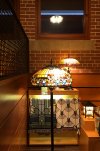 |
||
 |
 |
||||
We drove the short distance from Parkside to Downtown, wondering if the centre of Buffalo would be as derelict as downtown Rochester. Finding the Holiday Inn Express fairly easily, we parked in an adjacent street. The hotel wasn't the greatest - and worse, it was full of noisy, holiday-weekend guests, replacing the usual quota of business travellers.
We had a brief walk around the city centre as darkness was falling, and soon realised that central Buffalo was in a far better condition than the corresponding part of Rochester. There were plenty of interesting buildings to photograph and the daylight seemed to be fading alarmingly quickly.
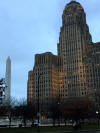 |
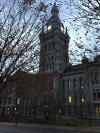 |
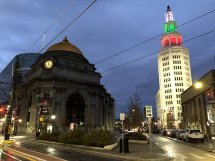 |
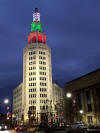 |
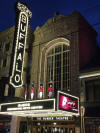 |
LEFT: A quick stroll around downtown Buffalo as darkness sets in |
Cocktails and dinner were in the branch of TGI Friday attached to the hotel, providing an opportunity to reflect on an amazingly full and varied day - one in which the poor weather had done nothing to dampen our enthusiasm.